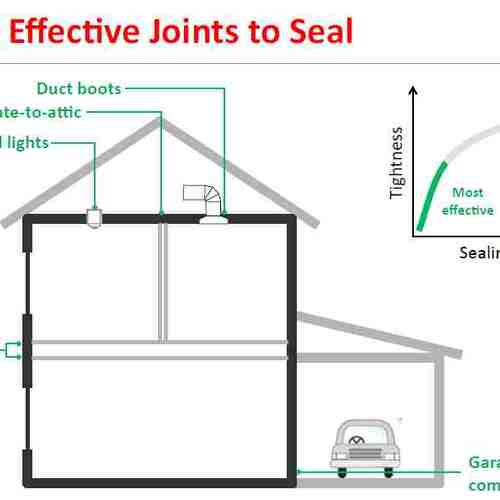
Image Credit: Mtsofan, from flickr.com
Image Credit: Mtsofan, from flickr.com The hole cut in the subfloor for the bathtub drain is often one of the biggest leaks in a home.
Image Credit: Energy Vanguard This mechanical closet was wide open to the attic; the closet had no ceiling. The two louvered doors into the living space meant there was a lot of air leakage.
Image Credit: Energy Vanguard The refrigerator vent in my in-laws' home was cut into the kitchen ceiling. At about two-thirds of a square foot, this hole alone can add 700 cfm50 to a blower door test.
Image Credit: Energy Vanguard This mystery vent was open to the attic at the top and connected to a louvered grille at the ceiling below.
Image Credit: Stuart Perkin The stack effect creates positive pressure at the top of a building and negative pressure at the bottom, which happens to be where the biggest holes are.
Image Credit: Energy Vanguard The stack effect in plastic: the plastic is getting sucked in at the bottom because of negative pressure and pushed out at the top by the positive pressure.
Image Credit: Energy Vanguard
Caulk your windows. Weatherstrip your doors. It’s that time of year again.
No, I don’t mean the time of year when you should do those things. I mean it’s the time of year when all the news stories that include this ineffective advice start appearing. There’s a lot of bad advice included in those articles, but let’s just look at why the caulking and weatherstripping advice will provide minimal relief.
The first problem with caulking and weatherstripping
I’ve written about this topic a number of times. Most recently, it was my article about bad energy saving tips on Clark Howard’s website. I covered a number of their bad tips but gave only a cursory answer to the caulking and weatherstripping issue:
That is Reason Number 1 that caulking and weatherstripping aren’t going to help a whole lot. When you’ve got really big holes in the ceiling or floor, the gaps around the windows and doors pale in comparison. For example, there’s the bathtub hole in the floor, as shown in Image #2 at the bottom of this page.
The open chase to the attic is another biggie (Image #3, below). The mechanical closet in the photo had no ceiling.
Occasionally contractors or homeowners put really crazy holes in the ceiling. My in-laws had a hole cut in their kitchen ceiling (Image #4, below), and the best I could figure was that the remodeling contractor who did their kitchen a few years earlier thought their refrigerator needed to be vented to the attic.
Another crazy hole found in someone’s home was the one shown in Image #5. It’s open at the top to the attic and connected to a louvered grille at the ceiling below. Stuart Perkin of Airtight Energy Inspections sent me this one and said it was one of three in that Colorado home. Even worse, he said it was installed by the builder, not a DIY homeowner.
The other problem with caulking and weatherstripping
I mention the other problem with caulking and weatherstripping just about every time I teach a class that includes understanding air leakage. Somehow, though, I don’t think I’ve ever put it here in the blog. Before I reveal what it is, let’s review the fundamentals of air leakage.
- For air to leak across the building enclosure, you need two things: a pressure difference and a pathway.
- Pressure differences are created by wind, the stack effect, and mechanical systems.
- For every cubic foot of air that leaks (or is blown) out of a home, another cubic foot leaks in somewhere else.
If you live in a windy place, wind can be a significant factor. You can’t control that pressure difference, so the best way to prevent it from stealing conditioned air from your home is to seal up the leaks. Go for all the big leaks you can find first.
Mechanical systems can create pressure differences, too. One of the hidden sources of this type of pressure difference is unbalanced duct leakage. Exhaust fans, including your clothes dryer, are another. You have some control here, and if you do things right, you shouldn’t have big pressure differences from the equipment in your home.
That leaves the stack effect. Warm air rises inside the home because it’s less dense than cold air. (Actually, it’s pushed upward by cold, dense air leaking in at the bottom, but let’s not get into all that controversial stuff right now.) Because of the different air densities, you end up different pressures in the house. As you see in the diagram below, you get positive pressure (inside higher than outside) at the top and negative pressure at the bottome of the house.
Air leaks when you have a pressure difference and a pathway, so you’ll get a lot more air leaking at the bottom and the top of the house than you do in the middle. In fact, you could even have an open window in the middle and get very little air leakage if you’re at what’s called the neutral pressure plane.
The last photo below shows the stack effect working its magic on a building under construction in Boston. The plastic is getting sucked in at the bottom because of negative pressure and pushed out at the top by the positive pressure.
The stack effect increases with building height and temperature difference between inside and out. Tall buildings on cold days get it the worst, but a two or three story home can experience significant air leakage due to the stack effect, too.
Should you caulk and weatherstrip?
The common advice for winterizing your home isn’t incorrect. Well, not completely anyway. It’s just that it’s likely to be ineffective because of two reasons:
- The big holes are in the floor and ceiling.
- The big pressure differences are at the top and bottom of the house.
Air leakage is one of the biggest problems with homes, so it’s absolutely worth going after it. Just be smart about it and go for the big leaks. Those standard tips for winterizing a home may give you a warm and fuzzy feeling but won’t give you a warm and cozy house.
Allison Bailes of Decatur, Georgia, is a speaker, writer, energy consultant, RESNET-certified trainer, and the author of the Energy Vanguard Blog. Check out his in-depth course, Mastering Building Science at Heatspring Learning Institute, and follow him on Twitter at @EnergyVanguard.
Weekly Newsletter
Get building science and energy efficiency advice, plus special offers, in your inbox.














10 Comments
OMG!
In picture # 2, is that what it appears to be, plank sheathing on an uninsulated unsealed wall there behind the tub? (With copper plumbing in the exterior wall no less!)
Nice visual on the stack effect with the plastic tarp draped building!
Response to Dana Dorsett
Dana,
Pipe staging enclosed by polyethylene provides a good opportunity for photographers to document the stack effect. In an old Q&A thread on GBA, you can find two more examples of this type of photo:
https://www.greenbuildingadvisor.com/community/forum/general-questions/24286/i-need-photo-stack-effect
Air sealing a PWF basment
Does anyone have a suggestion on the best way to air seal a basement with a Permanent wood foundation and wood floor? I've read about the importance of air sealing in basements with a slab especially along the slab edge, but this basement wouldn't have a slab. The floor would be framed on sleepers sitting on a gravel base covered with polyethylene. Would spray foaming along the bottom edges of the wall-gravel connection be sufficient? Or rather along the entirety of the floor in between the joists? Is air sealing down here even important enough?
The reason I'm asking is that I don't want all our air sealing techniques on the first floor to be wasted if I'm going to be leaving the basement susceptible. Thanks for any responses.
just a note . . . this is not
just a note . . . this is not my house, just a picture I attached for reference. We've not started our project yet.
Response to Dana Dorsett
That definitely seems to be wood seen through the bathtub hole, but I'm pretty sure that wasn't an exterior wall. It was an older house that had been renovated and this was in the new part (hence the plywood subfloor).
Boston was full of stack effect examples like the one shown here when I visited for the NESEA conference last year. It seemed everywhere I turned, there was another big building under construction and wrapped in plastic.
Response to Brian W
Brian,
You are definitely right to be concerned. Air can easily enter a building through the soil; since the basement is depressurized with respect to the outdoors due to the stack effect, outdoor air is pulled into the basement through the soil.
The other concern, of course, is radon. So you need a very good air barrier.
I would detail this just like a crawl space with polyethylene on the dirt floor. The more robust the air barrier/vapor barrier membrane, the better. At a minimum, use 6 mil poly; other options include a 20-mil pool liner or Tu-Tuf poly.
All air barrier/vapor barrier seams need to be carefully sealed with high quality tape or mastic, and the air barrier/vapor barrier under the subfloor needs to be sealed to the air barrier membrane on the walls.
For more information, see:
Building an Unvented Crawl Space
All About Radon
uninsulated bathtub wall and suicide vent
My house started out with plenty of giant air leaks, including the classic hole under the bathtub, and an uninsulated patch of exterior wall behind the end of the bathtub. The plumbing is at the other end, so no plumbing in an uninsulated exterior wall, but it seems that the plumbers put in the bathtub before the insulation was installed and it wasn't worth figuring out how to put insulation behind the bathtub. That's not quite as bad as what Dana saw in the picture here, but it's similar.
But that's not the worst such flaw--I think the worst was the floor vent in the master bedroom, going straight through the floor to the garage underneath. No ductwork anywhere in the house, so it's not an abandoned heating register. It's hard to imagine a reason for that vent other than as a provision for murder or suicide.
Brian
You wrote ". . . this is not my house, just a picture I attached for reference."
Good! That is some of the oddest floor framing I've ever seen.
Thanks Martin
I did some more searching and found someone spray foaming the gravel base under the floor. Should be closed cell right? And I wouldn't need the Tu-Tuf or pool liner? Would this also mitigate the radon issue if there was one?
Response to Brian W
Brian,
Yes, you can apply closed-cell spray foam to compacted gravel. This method is usually used before a slab is poured over the cured foam, but it would work under the type of wood-framed floor you are envisioning.
Properly installed, closed-cell spray foam is a good air barrier, so it would prevent the entry of air or radon through your basement floor. You could indeed skip the polyethylene or Tu-Tuf if you used spray foam.
Closed-cell spray foam has several disadvantages over EPS, however -- it is far more expensive, and it is manufactured with a blowing agent with a very high global warming potential. If you want insulation, why not just install rigid foam with taped seams?
Log in or create an account to post a comment.
Sign up Log in